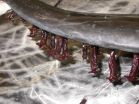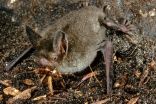(Press-News.org) Like homing pigeons, humans have a nose for navigation because our brains are wired to convert smells into spatial information, new research from the University of California, Berkeley, shows.
While humans may lack the scent-tracking sophistication of, say, a search-and-rescue dog, we can sniff our way, blindfolded, toward a location whose scent we've smelled only once before, according to the UC Berkeley study published today (June 17) in the journal PLOS ONE.
Similar investigations have been conducted on birds and rodents, but this is the first time smell-based navigation has been field-tested on humans. The results evoke a GPS-like superpower one could call an "olfactory positioning system."
"What we've found is that we humans have the capability to orient ourselves along highways of odors and crisscross landscapes using only our sense of smell," said study lead author Lucia Jacobs, a UC Berkeley psychology professor who studies evolution and cognition in animals and humans.
Smell is a primitive sense that our early ancestors used for foraging, hunting and mating, among other skills necessary for survival. Early sailors and aviators gave anecdotal reports of using odors to navigate, but there have been no experiential scientific studies on this until now.
The process of smelling, or olfaction, is triggered by odor molecules traveling up the nasal passage, where they are identified by receptors that send signals to the olfactory bulb - which sits between the nasal cavity and the brain's frontal lobe - and processes the information. A key to the connection between smell, memory and navigation is that olfactory bulbs have a strong neural link to the brain's hippocampus, which creates spatial maps of our environment.
"Olfaction is like this background fabric to our world that we might not be conscious of, but we are using it to stay oriented," Jacobs said. "We may not see a eucalyptus grove as we pass it at night, but our brain is encoding the smells and creating a map."
Pigeons and rats, for example, are known to orient themselves using odor maps, or "smellscapes," but sighted humans rely more heavily on visual landmarks, and so the study turned up some surprising results.
Two dozen young adults were tested on orientation and navigation tasks under various scenarios in which their hearing, sight or smell was blocked. The test location was a 25-by-20-foot room where 32 containers with sponges were placed at points around the edge of the room. Two of the sponges were infused with essential oils such as sweet birch, anise or clove.
In the smell-only experiment, study participants were led, one at a time, into the room wearing blindfolds, earplugs and headphones and walked in circles for disorientation purposes. They spent a minute at a specific point on the grid, where they inhaled a combination of two fragrances. After being walked in circles again for disorientation purposes, they were tasked with sniffing their way back to the starting point where they had smelled the two fragrances.
Overall, study participants navigated relatively closely to the targeted location when using only their sense of smell, compared to when other sensory inputs were blocked. Moreover, they were not just following one scent, but using information from both scents to orient themselves toward a point on an odor grid.
"We never thought humans could have a good enough sense of smell for this," said Jacobs. But in retrospect, she noted, the results are "as obvious as the nose on my face."
Jacobs will be exploring this mechanism further as a scientist selected to be on the team of the National Science Foundation's "Cracking the Olfactory Code" Ideas Lab, which takes place this summer.
INFORMATION:
In addition to Jacobs, co-authors on the study are UC Berkeley researchers Jennifer Arter, Amy Cook and Frank Sulloway.
(New York, June 17, 2015) Melanoma patients with high levels of a protein that controls the expression of pro-growth genes are less likely to survive, according to a study led by researchers at Icahn School of Medicine at Mount Sinai and published online in the journal Molecular Cell.
The research team found that the protein, called H2A.Z.2, promotes the abnormal growth seen in melanoma cells as they develop into difficult-to-treat tumors. H2A.Z.2 is part of the chromosome structure that packages genes, and has the ability to switch them on off. Having high levels of ...
Men with an elevated, genetically inherited risk for prostate cancer could be routinely identified with a simple blood or urine test, scientists at UC San Francisco and Kaiser Permanente Northern California have concluded, potentially paving the way to better or earlier diagnosis.
The study, which compared 7,783 men with prostate cancer to 38,595 men without the disease, is available online and will be published in an upcoming issue of the journal Cancer Discovery.
The new study is one of the first to come out of the collaboration between UCSF and Kaiser Permanente ...
A typical computer chip includes millions of transistors connected with an extensive network of copper wires. Although chip wires are unimaginably short and thin compared to household wires both have one thing in common: in each case the copper is wrapped within a protective sheath.
For years a material called tantalum nitride has formed protective layer in chip wires.
Now Stanford-led experiments demonstrate that a different sheathing material, graphene, can help electrons scoot through tiny copper wires in chips more quickly.
Graphene is a single layer of carbon ...
Metastatic colorectal cancer patients tend to live longer when they respond to the first line of chemotherapy their doctors recommend. To better predict how patients will respond to chemotherapy drugs before they begin treatment, researchers at University of California, San Diego School of Medicine conducted a proof-of-principle study with a small group of metastatic colorectal cancer patients. The results, published June 17 in PLOS ONE, revealed two genes that could help physicians make more informed treatment decisions for patients with this disease.
Metastatic colorectal ...
People with lower educational levels and incomes are less likely to know about yoga, acupuncture, natural products and chiropractic medicine, according to a new study from San Francisco State University.
Studies on the use of complementary and alternative medicine (CAM) have typically focused on learning more about who use these types of practices and why. Less is known about trends among those who do not partake, which inspired new research by Professor of Health Education Adam Burke, published in PLOS ONE on June 17.
"It's very important to know why somebody is not ...
Higher consumption of dietary trans fatty acids (dTFA), commonly used in processed foods to improve taste, texture and durability, has been linked to worsened memory function in men 45 years old and younger, according to a University of California, San Diego School of Medicine study published online on June 17 in PLOS ONE.
Researchers evaluated data from 1,018 men and women who were asked to complete a dietary survey and memory test involving word recall. On average, men aged 45 and younger recalled 86 words; however, for each additional gram of trans fats consumed daily, ...
Visitation at U.S. National Parks may potentially increase with increasing temperature in temperate areas, but may decrease with temperatures rising over 80 degrees Fahrenheit, according to a study using future climate and visitation modeling scenarios published June 17 in the open-access journal PLOS ONE by Nicholas Fisichelli and colleagues from U.S. National Park Service.
Climate change may affect not only natural and cultural resources within protected areas, but also park tourism. To assess the relationship between climate and park visitation, the authors of this ...
Highly specialized coronulid barnacles may be able to identify and attach to the fins of quick-swimming dolphins, locating areas suited for finding food and developing larvae, according to a study carried out as a collaboration between the University of Valencia, Spain, and the University of Southern Mississippi, and published June 17, 2015 in the open-access journal PLOS ONE by Juan Carrillo and colleagues.
Scientists have reported several types of symbiotic barnacles that settle on living host organisms. The highly specialized coronulid barnacle, Xenobalanus globicipitis, ...
San Diego, June 17 -- A team of researchers led by bioengineers at the University of California, San Diego provide new insights on how hearts 'stay young' and keep functioning over a lifetime despite the fact that most organisms generate few new heart cells. Identifying key gene expression changes that promote heart function as organisms age could lead to new therapy targets that address age-related heart failure.
The researchers found that the contractile function of the hearts of fruit flies is greatly improved in flies that overexpress the protein vinculin, which also ...
Sydney, Australia - Fossilised remains of a new bat species, which lived 16 million years ago, walked on four limbs and was three times larger than today's average bat, have been discovered in New Zealand.
The fossils were found near Central Otago on South Island, in sediment left over from a vast prehistoric body of water known as Lake Manuherikia, which was part of warmer subtropical rainforest during the early Miocene era, between 16 and 19-million-years-ago.
The new species, Mystacina miocenalis, was described today in the journal PLOS ONE, and is related to another ...

